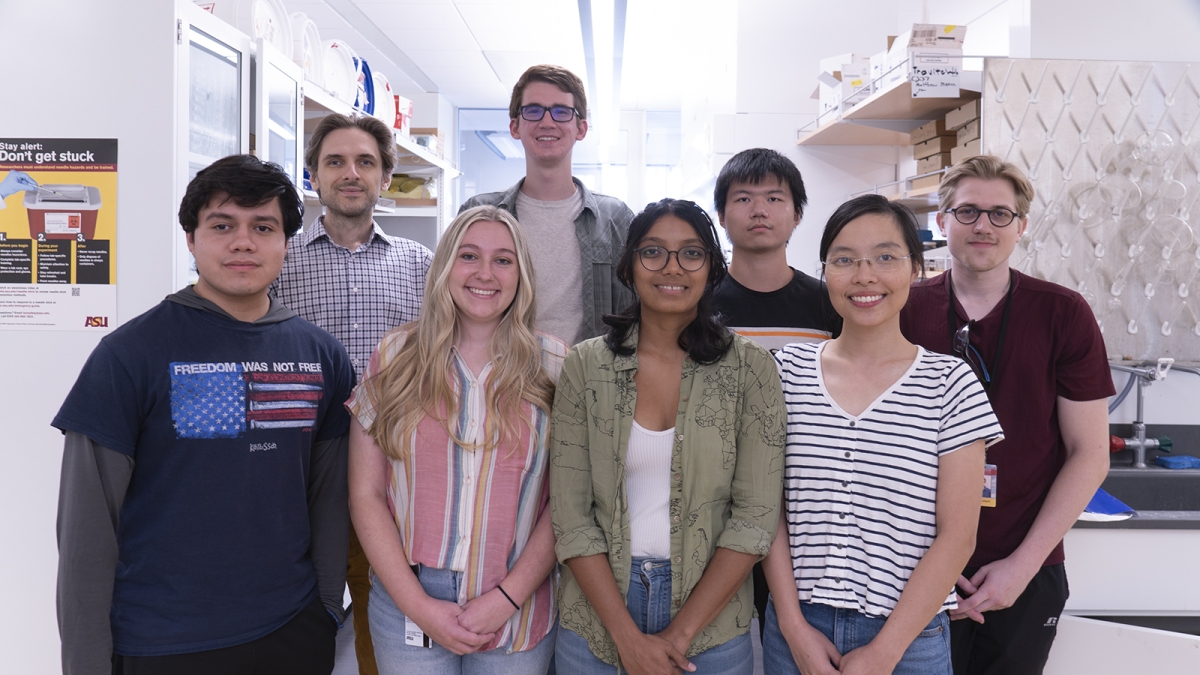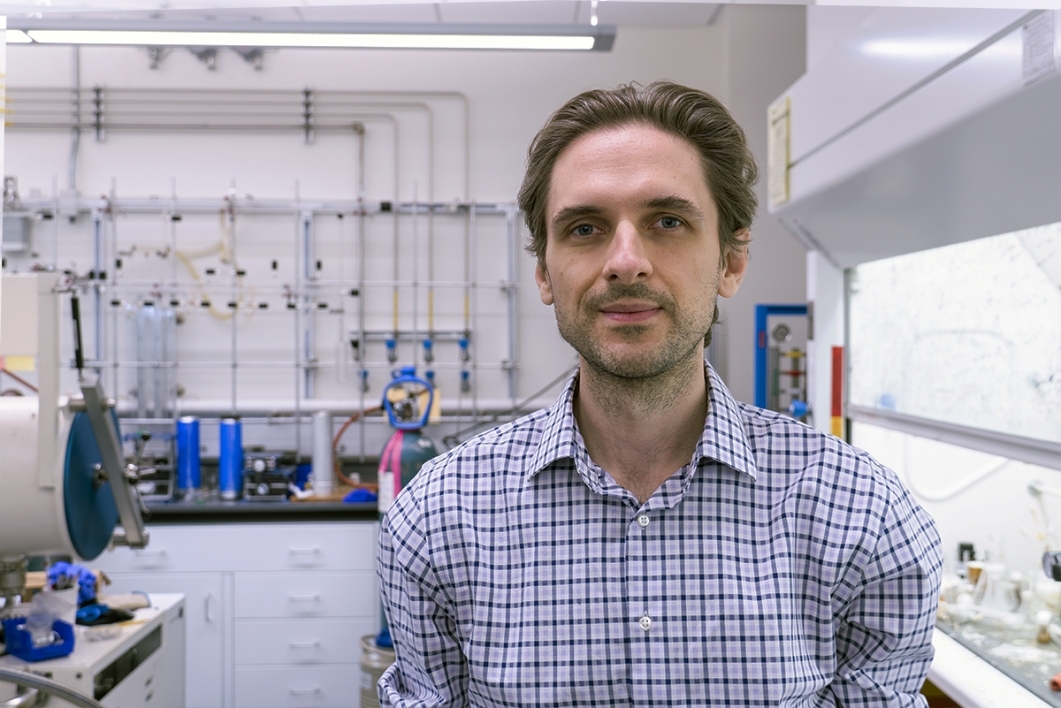ASU professor, students advance ecologically responsible chemistry

Ryan Trovitch and his research group in the ASU School of Molecular Sciences. Front row, left to right: Michael Trimble, Elizabeth March, Anuja Sharma and Thao Nguyen. Back row, left to right: Ryan Trovitch, Riley Seminara, Yichen Yan and Brock Leland. Photo courtesy Mary Zhu/School of Molecular Sciences
At Arizona State University's School of Molecular Sciences, ecological, ethical and molecular ways of thinking are being combined to design processes that are less hazardous, less polluting and more sustainable.
Associate Professor Ryan Trovitch and his students are taking this approach to improve chemical reactions by minimizing the use of toxic solvents and designing sustainable catalysts that offer enhanced energy efficiency.
Catalysts for many reactions use precious metals such as rhodium and platinum, which are rarely found in high concentrations on Earth. This scarcity makes them expensive to mine and purify, and these processes can change entire landscapes and generate a considerable amount of waste.
These metals are also inherently toxic to humans and must be removed from pharmaceuticals and other fine chemicals before being sold to consumers.
That's why researchers in Trovitch’s lab are designing catalysts based on biologically-benign metals, such as manganese, iron and cobalt. These metals are much more abundant on Earth and are far less expensive to obtain.
Some of the reagentsA substance or mixture for use in chemical analysis or other reactions. Trovitch and his students have created are the most efficient reagents that have ever been recorded for specific reactions.
“We have developed some of the most active catalysts that are known for the reduction of unsaturated organic compounds,” Trovitch said. “This is noteworthy not only because of the turnover frequencies that are being observed, but also because we can use very low loadings of the Earth-abundant metal catalyst, avoid the use of solvent and run the reactions at room temperature.”
“The need to switch from precious metals to common metals for catalysis has been recognized for years; the issue is a fundamental one of directing electron flow, which precious metals just do better,” said Ian Gould, former director of the School of Molecular Sciences. “However, Ryan and his group have invented clever ways of using ligands to allow common metals to control electrons the same way that precious metals can.”
Manganese and nickel catalysts that were developed in the Trovitch lab have been commercialized in partnership with Sigma-Aldrich and ASU’s technology transfer office, Skysong Innovations. These catalysts were first discovered by Tufan MukhopadhyayMukhopadhyay is currently a postdoctoral researcher at NYU and Porter received his PhD from UCSD before accepting a staff scientist position at SRI International., who earned his PhD from the School of Molecular Sciences, and Tyler Porter, a graduate of the school who completed an honors thesis on the project.
ASU School of Molecular Sciences Associate Professor Ryan Trovitch. Photo Courtesy Mary Zhu/School of Molecular Sciences
Trovitch and his students use mechanistic insight to guide the development of sustainable metal catalysts and to identify potential applications. For example, manganese catalysts developed in their lab have been used to replace platinum catalysts used in silicone curing, a reaction that allows for the production of oxygen-permeable contact lenses, transparent LED screen coatings, and silicone adhesives.
More recently, researchers in the group have discovered that manganese catalysts can be used to form Si‒N bonds in an atom-efficient way from silane and amine coupling partners. The corresponding silylamines are used in industry to deposit coatings that prevent the oxidation of silicon in semiconductors and solar panels.
The Trovitch lab is currently expanding these efforts to develop halogen-free methods of preparing organic polysilazanes. Solutions containing these polymers are often sprayed onto metal surfaces to protect them from corrosion and extreme temperatures; one relatable example is the application of clearcoat to protect automobile paint.
Because of their widespread use, developing catalysts that produce polysilazanes without the need for elaborate purification can minimize waste generation and circumvent the use of corrosive reagents.
As a member of the Green Chemistry Commitment Advisory Board, Trovitch has collaborated with ecologists, toxicologists and industry stakeholders to develop educational content aimed at preparing future chemists to consider the environmental impacts of the reactions that they perform. The students advised by Trovitch are being recognized for successfully applying these concepts.
Thu Thao Nguyen, a graduate student in the lab, received this year’s SMS Innovation Award for developing a sustainable method of preparing semiconductor coatings.
VIDEO: Learn more about Nguyen's research
A second graduate student who is developing new catalysts, Anuja Sharma, recently received an SMS Outstanding Graduate Student Award. Michael Trimble, one of this year’s Sustainable Chemistry and Catalysis REU Fellows, is using atom-efficient coupling reactions to prepare new protective coatings.
“Chemistry must respond to changing societal needs and pressures, and must take ecological and ethical considerations into account when developing new science," Gould said. "The kind of chemistry that Ryan and his group are doing takes us in that direction."
More Science and technology

ASU-led space telescope is ready to fly
The Star Planet Activity Research CubeSat, or SPARCS, a small space telescope that will monitor the flares and sunspot activity…

ASU at the heart of the state's revitalized microelectronics industry
A stronger local economy, more reliable technology, and a future where our computers and devices do the impossible: that’s the…

Breakthrough copper alloy achieves unprecedented high-temperature performance
A team of researchers from Arizona State University, the U.S. Army Research Laboratory, Lehigh University and Louisiana State…


